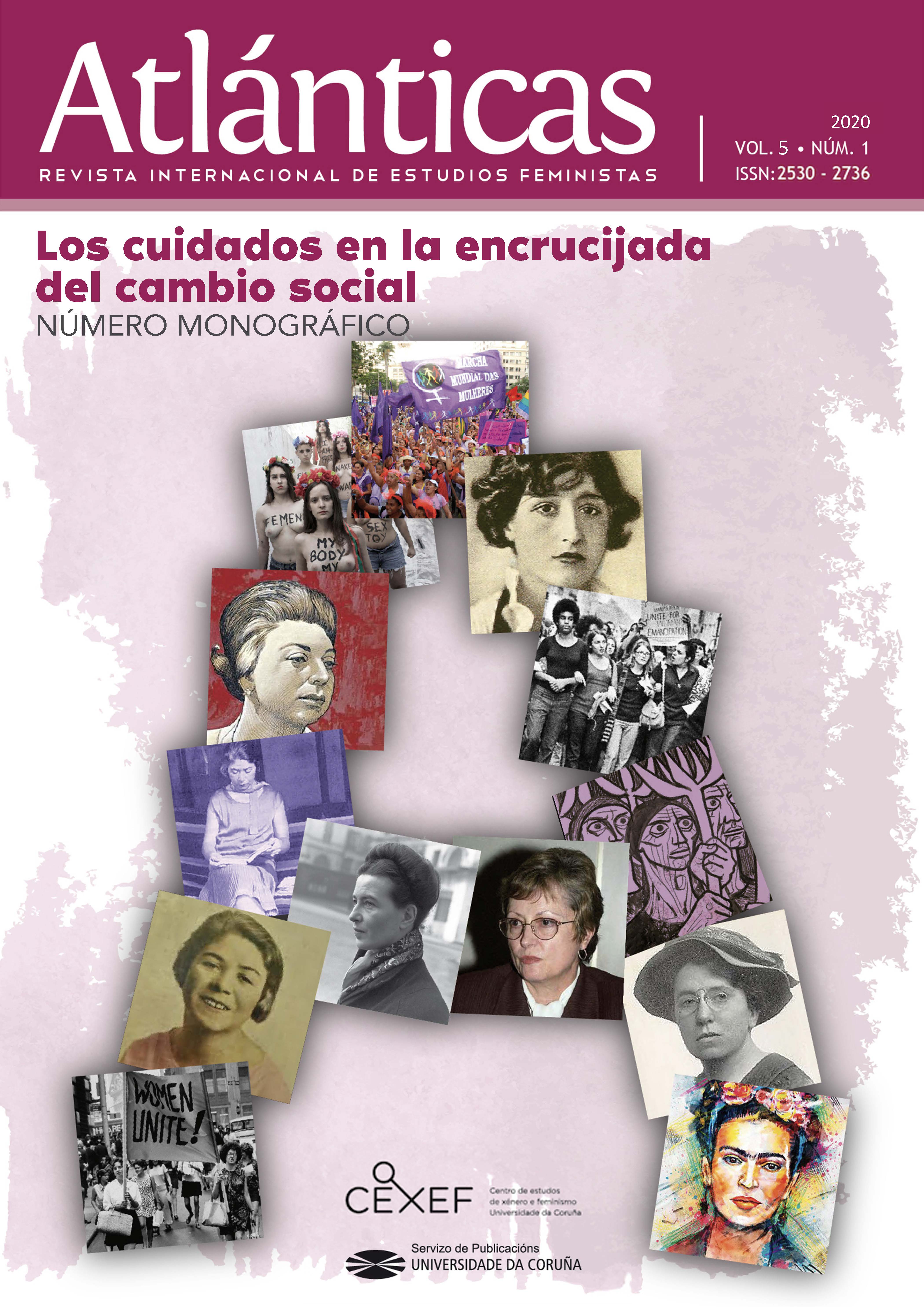Cartografía de la organización de las trabajadoras domésticas a nivel mundial
Contenido principal del artículo
Resumen
Las trabajadoras domésticas se enfrentan a numerosos problemas para poder organizarse, como la descentralización de la población activa o la naturaleza de su relación laboral. Este artículo analiza, a partir de la comparación de varios países, cómo se organizan las trabajadoras del hogar pese a estas limitaciones. Identificamos tres formas organizativas: el modelo sindical y el modelo asociativo (Shireen Ally). Proponemos un tercer modelo, el “tipo híbrido”, en el que las trabajadoras domésticas se organizan “entre ellas” en asociaciones y, al mismo tiempo, estas asociaciones están vinculadas o integradas en sindicatos, lo que les proporciona representación, servicios y contacto con otros/as trabajadores/as. En relación con este hallazgo, observamos también una tendencia hacia un “sindicalismo emergente”; esto es, encontramos formas organizativas más relacionadas con los sindicatos que hace una década. Un factor explicativo reside en la “lucha por la gobernanza” tras la victoria del Congreso de la Organización Internacional del Trabajo en 2011 sobre “Trabajo Decente para las Trabajadoras Domésticas”, que condujo a una mayor colaboración y confianza entre las trabajadoras del hogar organizadas y los sindicatos.
Palabras clave:
Descargas
Detalles del artículo
Citas
AK Strategic Unionism (2013). Jenaer Machtressourcenansatz 2.0. IN S. Schmalz, K. Dörre (ed.), Comeback der Gewerkschaften?: Machtressourcen, innovative Praktiken, internationale Perspektiven (pp. 345–375). Frankfurt/Main; New York: Campus.
Ally, Shireen (2005). Caring about Care Workers: Organising in the Female Shadow of Globalisation. Women and Globalization Conference. www.globaljusticecenter.org/papers2005/ally_eng.htm (13.09.2009).
Anderson, Bridget (2000). Doing the Dirty Work. The Global Politics of Domestic Labour. London/New York: Zed Books.
Boris, Eileen and Premilla Nadasen (2008). Domestic Workers Organize! Working USA. The Journal of Labor and Society, 11, 413–437.doi: https://doi.org/10.1111/j.1743-4580.2008.00217.x
Das Gupta, Monisha (2006). Unruly Immigrants. Rights, Activism, and Transnational South Asian Politics in the United States. Durham: Duke UP.
Delp, Linda and Katie Quan (2002). Homecare Worker Organizing in California. An Analysis of a Successful Strategy. Labour Studies Journal, 27, 1, 1-23. doi: https://doi.org/10.1177/0160449X0202700102
Eleveld, Anja and Franca Van Hooren (2018). The Governmentalization of the Trade Union and the Potential of Union-Based Resistance. The Case of Undocumented Migrant Domestic Workers in the Netherlands Making Rights Claims. Social & Legal Studies, 27, 596–615. doi: https://doi.org/10.1177/0964663917725145
Ford, Michele (2004). Organizing the Unorganizable: Unions, NGOs, and Indonesian Migrant Labour. International Migration, 42, 5, 99-117. doi: https://doi.org/10.1111/j.0020-7985.2004.00303.x
Goldberg, Harmony (2014). Our Day Has Finally Come: Domestic Worker Organizing in New York City. CUNY Academic Works. https://academicworks.cuny.edu/gc_etds/422.
Heimeshoff, Lisa-Marie and Helen Schwenken (2013): „…das bisschen Haushalt, sagt mein Mann“. Die politische Regulierung von Haushaltsarbeit und Implikationen für die geschlechtliche Arbeitsteilung. ARBEIT. Zeitschrift für Arbeitsforschung, Arbeitsgestaltung und Arbeitspolitik, 22: 199–211.
Hobden, Claire (2010). Winning Fair Labour Standards for Domestic Workers: Lessons Learned from the Campaign for a Domestic Worker Bill of Rights in New York State. International Labour Organization, Global Union Research Network, Working Paper No. 14. Geneva.
Hondagneu-Sotelo, Pierrette and Cristina Riegos (1997). Sin Organizacion, No Hay Solucion: Latina Domestic Workers and Non-traditional Labor Organizing. Latino Studies Journal, 8, 54–81.
Kanyoka, Vicky (2017). Organising domestic workers across Africa: a regional view. Venice: Open Democracy.
ICFTU, International Confederation of Free Trade Unions (2002). Women Migrant Domestic Workers: Bringing the Sector into the Open. Trade Union World Briefing.
ILO, International Labour Office (2009). Decent Work for Domestic Workers. Law and Practice Report IV (1). Geneva.
ILO, International Labour Organization (2011). C189 Domestic Workers Convention, 2011. Convention concerning decent work for domestic workers. Geneva. http://www.ilo.org/ilolex/cgi-lex/convde.pl?C189 (28.09.2011).
ILO, International Labour Office (2015). Domestic work voice and representation through organizing. Domestic Work, Policy Brief, 8, author: C. Hobden.
Isaksen, Lisa Widding, Sambasivan Uma Devi and Arlie Russell Hochschild (2008). Global Care Crisis: A Problem of Capital, Care Chain, or Commons?. American Behavioral Scientist, 52, 3, 405–425. doi: https://doi.org/10.1177/0002764208323513
Jayaraman, Sarumathi and Immanuel Ness (ed.) (2005). The New Urban Immigrant Workforce: Innovative Models for Labor Organizing. Armonk: Routledge.
Jenkins, Steve (2002). Organizing, Advocacy, and Member Power. Working USA, 6, 2, 56–89. doi: https://doi.org/10.1111/j.1743-4580.2002.00003.x-i1
Marino, Stefania, Judith Roosblad and Rinus Penninx (ed.) (2017). Trade Unions and Migrant Workers. Cheltenham, Geneva: Edward Elgar.
McCallum, Jamie K. (2013). Global unions, local power: the new spirit of transnational labor organizing. Ithaca: Cornell UP.
Milkman, Ruth (2006). L.A. Story: Immigrant Workers and the Future of the U.S. Labor Movement. New York: Russell Sage Foundation.
Raaphorst, Donna L. Van (1988). Union Maids Not Wanted: Organizing Domestic Workers 1870-1940. New York: Praeger.
Rhee, Nari and Carol Zabin (2009). Aggregating dispersed workers: Union organizing in the “care” Industries. Geoforum, 40, 969-979. doi: https://doi.org/10.1016/j.geoforum.2009.08.006
Roberts, Laura (2011). An Examination into the Organization of Migrant Domestic Workers in Alberta/Canada. Background paper of the Global Labour University research group "Organizing and mobilizing of domestic workers in international comparison".
Ross, Stephanie (2007). Varieties of Social Unionism: Towards a Framework for Comparison. Just Labour: A Canadian Journal of Work and Society, 11, 16–34. doi: https://doi.org/10.25071/1705-1436.84
Schmalz, Stefan, Carmen Ludwig and Edward Webster (2018). The Power Resources Approach: Developments and Challenges. Global Labour Journal 9, 2, 113-133. doi: https://doi.org/10.15173/glj.v9i2.3569
Schwenken, Helen (2017). The emergence of an ‘impossible’ movement: domestic workers organize globally. In D. Rucht and D. Gosewinkel (ed.), Transnational Social Movements, 205–228. New York: Berghan.
Shamir, Hila and Guy Mundlak (2011). Bringing Together or Drifting Apart? Targeting Care Work as “Work Like No Other”. Canadian Journal of Women and the Law, 23, 289–308. doi: https://doi.org/10.3138/cjwl.23.1.289
Silver, Beverly J. (2003). Forces of Labor: Workers’ Movements and Globalization since 1870. Cambridge: Cambridge UP.
Smith, Peggie R. (2000). Organizing the Unorganizable: Private Paid Household Workers and Approaches to Employee Representation. New Carolina Law Review, 79, 45-110.
Tait, Vanessa (2005). Poor Workers’ Unions: Rebuilding Labor from Below. Chicago: Haymarket Books.
Wright, Erik Olin (2000). Working-class power, capitalist-class interests, and class compromise. American Journal of Sociol Sociology, 105, 4, 957–1002.

